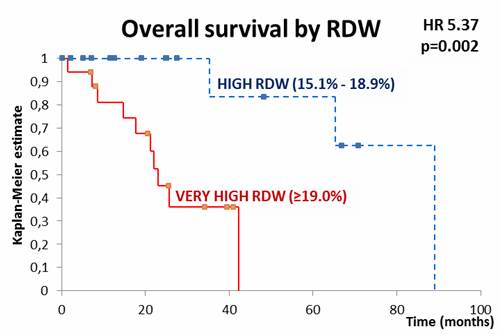CLINICAL SIGNIFICANCE OF ANISOCYTOSIS IN NEWLY-DIAGNOSED PATIENTS WITH PRIMARY MYELOFIBROSIS
(Abstract release date: 05/19/16)
EHA Library. Lucijanic M. 06/09/16; 134935; PB2035

Dr. Marko Lucijanic
Contributions
Contributions
Abstract
Abstract: PB2035
Type: Publication Only
Background
Red cell distribution width (RDW) provides a quantitative measure of anisocytosis and it is associated with the presence of subclinical systemic inflammation and a poor outcome in a variety of diseases when elevated. Anisocytosis is a feature of primary myelofibrosis (PMF) but it’s prognostic role in PMF has not yet been evaluated.
Aims
To determine whether anisocytosis bears prognostic significance in patients with PMF and its relation to disease features.
Methods
33 newly-diagnosed patients with PMF were analyzed in this study. Baseline RDW values were obtained in addition to other routine blood analyses (CRP, LDH, complete blood count and iron metabolism parameters) and JAK2 V617F mutational status. Patients were staged according to IPSS prognostic scoring system, liver and spleen size were assessed by palpation.The Mann Whitney U test, the Pearson correlation and the Χ2 test/ the Fisher test were used where appropriate. Survival analyses were performed using methods of Kaplan and Meier, the log-rank test and the Cox regression analysis. All statistical tests were two-sided and P values <0.05 were considered significant.
Results
Median RDW was 19.0% (15.2% - 22.5%). RDW correlated significantly with hemoglobin (p=0.005), CRP (p=0.031), spleen size (p=0.036) and IPSS score (p=0.003). Patients with more pronounced anisocytosis had an inferior overall survival (OS) – very-high RDW (≥19.0%) vs. high RDW (15.1% - 18.9%) subgroup, HR 5.37, p=0.002. RDW remained significantly associated with OS (p=0.002) in a multivariate model including IPSS score, hemoglobin level and CRP.
Conclusion
PMF pathogenesis surpasses inflammation as only cause of anisocytosis. A higher degree of anisocytosis is associated with more advanced disease features and a decreased overall survival. RDW encompasses standard prognostic score and may help in the rapid detection of patients with an unfavorable prognosis.

Session topic: E-poster
Keyword(s): Idiopathic myelofibrosis, Red blood cell, Spleen, Survival prediction
Type: Publication Only
Background
Red cell distribution width (RDW) provides a quantitative measure of anisocytosis and it is associated with the presence of subclinical systemic inflammation and a poor outcome in a variety of diseases when elevated. Anisocytosis is a feature of primary myelofibrosis (PMF) but it’s prognostic role in PMF has not yet been evaluated.
Aims
To determine whether anisocytosis bears prognostic significance in patients with PMF and its relation to disease features.
Methods
33 newly-diagnosed patients with PMF were analyzed in this study. Baseline RDW values were obtained in addition to other routine blood analyses (CRP, LDH, complete blood count and iron metabolism parameters) and JAK2 V617F mutational status. Patients were staged according to IPSS prognostic scoring system, liver and spleen size were assessed by palpation.The Mann Whitney U test, the Pearson correlation and the Χ2 test/ the Fisher test were used where appropriate. Survival analyses were performed using methods of Kaplan and Meier, the log-rank test and the Cox regression analysis. All statistical tests were two-sided and P values <0.05 were considered significant.
Results
Median RDW was 19.0% (15.2% - 22.5%). RDW correlated significantly with hemoglobin (p=0.005), CRP (p=0.031), spleen size (p=0.036) and IPSS score (p=0.003). Patients with more pronounced anisocytosis had an inferior overall survival (OS) – very-high RDW (≥19.0%) vs. high RDW (15.1% - 18.9%) subgroup, HR 5.37, p=0.002. RDW remained significantly associated with OS (p=0.002) in a multivariate model including IPSS score, hemoglobin level and CRP.
Conclusion
PMF pathogenesis surpasses inflammation as only cause of anisocytosis. A higher degree of anisocytosis is associated with more advanced disease features and a decreased overall survival. RDW encompasses standard prognostic score and may help in the rapid detection of patients with an unfavorable prognosis.

Session topic: E-poster
Keyword(s): Idiopathic myelofibrosis, Red blood cell, Spleen, Survival prediction
Abstract: PB2035
Type: Publication Only
Background
Red cell distribution width (RDW) provides a quantitative measure of anisocytosis and it is associated with the presence of subclinical systemic inflammation and a poor outcome in a variety of diseases when elevated. Anisocytosis is a feature of primary myelofibrosis (PMF) but it’s prognostic role in PMF has not yet been evaluated.
Aims
To determine whether anisocytosis bears prognostic significance in patients with PMF and its relation to disease features.
Methods
33 newly-diagnosed patients with PMF were analyzed in this study. Baseline RDW values were obtained in addition to other routine blood analyses (CRP, LDH, complete blood count and iron metabolism parameters) and JAK2 V617F mutational status. Patients were staged according to IPSS prognostic scoring system, liver and spleen size were assessed by palpation.The Mann Whitney U test, the Pearson correlation and the Χ2 test/ the Fisher test were used where appropriate. Survival analyses were performed using methods of Kaplan and Meier, the log-rank test and the Cox regression analysis. All statistical tests were two-sided and P values <0.05 were considered significant.
Results
Median RDW was 19.0% (15.2% - 22.5%). RDW correlated significantly with hemoglobin (p=0.005), CRP (p=0.031), spleen size (p=0.036) and IPSS score (p=0.003). Patients with more pronounced anisocytosis had an inferior overall survival (OS) – very-high RDW (≥19.0%) vs. high RDW (15.1% - 18.9%) subgroup, HR 5.37, p=0.002. RDW remained significantly associated with OS (p=0.002) in a multivariate model including IPSS score, hemoglobin level and CRP.
Conclusion
PMF pathogenesis surpasses inflammation as only cause of anisocytosis. A higher degree of anisocytosis is associated with more advanced disease features and a decreased overall survival. RDW encompasses standard prognostic score and may help in the rapid detection of patients with an unfavorable prognosis.

Session topic: E-poster
Keyword(s): Idiopathic myelofibrosis, Red blood cell, Spleen, Survival prediction
Type: Publication Only
Background
Red cell distribution width (RDW) provides a quantitative measure of anisocytosis and it is associated with the presence of subclinical systemic inflammation and a poor outcome in a variety of diseases when elevated. Anisocytosis is a feature of primary myelofibrosis (PMF) but it’s prognostic role in PMF has not yet been evaluated.
Aims
To determine whether anisocytosis bears prognostic significance in patients with PMF and its relation to disease features.
Methods
33 newly-diagnosed patients with PMF were analyzed in this study. Baseline RDW values were obtained in addition to other routine blood analyses (CRP, LDH, complete blood count and iron metabolism parameters) and JAK2 V617F mutational status. Patients were staged according to IPSS prognostic scoring system, liver and spleen size were assessed by palpation.The Mann Whitney U test, the Pearson correlation and the Χ2 test/ the Fisher test were used where appropriate. Survival analyses were performed using methods of Kaplan and Meier, the log-rank test and the Cox regression analysis. All statistical tests were two-sided and P values <0.05 were considered significant.
Results
Median RDW was 19.0% (15.2% - 22.5%). RDW correlated significantly with hemoglobin (p=0.005), CRP (p=0.031), spleen size (p=0.036) and IPSS score (p=0.003). Patients with more pronounced anisocytosis had an inferior overall survival (OS) – very-high RDW (≥19.0%) vs. high RDW (15.1% - 18.9%) subgroup, HR 5.37, p=0.002. RDW remained significantly associated with OS (p=0.002) in a multivariate model including IPSS score, hemoglobin level and CRP.
Conclusion
PMF pathogenesis surpasses inflammation as only cause of anisocytosis. A higher degree of anisocytosis is associated with more advanced disease features and a decreased overall survival. RDW encompasses standard prognostic score and may help in the rapid detection of patients with an unfavorable prognosis.

Session topic: E-poster
Keyword(s): Idiopathic myelofibrosis, Red blood cell, Spleen, Survival prediction
{{ help_message }}
{{filter}}


